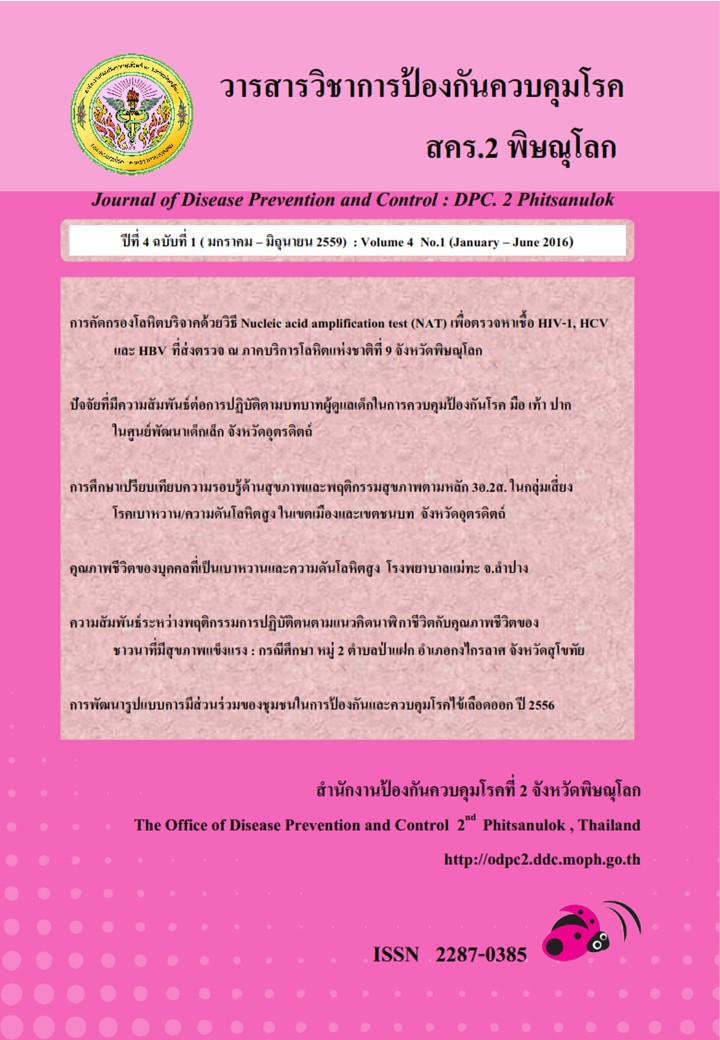การคัดกรองโลหิตบริจาคด้วยวิธี Nucleic acid amplification test (NAT) เพื่อตรวจหาเชื้อ HIV-1, HCV และ HBV ที่ส่งตรวจ ณ ภาคบริการโลหิตแห่งชาติที่ 9 จังหวัดพิษณุโลก
Main Article Content
บทคัดย่อ
ภาคบริการโลหิตแห่งชาติที่ 9 จังหวัดพิษณุโลก ได้ตรวจคัดกรองโลหิตบริจาคด้วยวิธี nucleic acid amplification test (NAT) แบบรวม 6 ตัวอย่าง เพื่อตรวจหา HIV-1, HCV และ HBV แม้ว่าในปัจจุบันจะมีการผลิต โลหิตสังเคราะห์แต่คุณสมบัติต่างๆ ยังไม่สามารถทดแทนโลหิตของมนุษย์ได้ เนื่องจากเป็นสารสังเคราะห์ ไม่สามารถย่อยสลายได้ตามกระบวนการเมทตาบอลิซึมของร่างกาย การตรวจคัดกรองโลหิตบริจาค ด้วยวิธี NAT นี้ จะทําให้โลหิตมีความปลอดภัยต่อผู้รับ ตามมาตรฐานขององค์การอนามัยโลก โดยมีวัตถุประสงค์เพื่อ ศึกษาอัตรา การตรวจพบเชื้อ HIV-1, HCV และ HBV ที่ทดสอบด้วยวิธี NAT (NAT yield rate) เพื่อช่วยลดความสี่ยงต่อการติดเชื้อ จากการรับเลือดและทําให้โลหิตมีความปลอดภัยมากขึ้นอีกระดับหนึ่ง ทั้งนี้เพื่อประโยชน์ของผู้ป่วย ซึ่งศึกษา ด้วยวิธี ทําการทดสอบ NAT ในตัวอย่างโลหิตบริจาคที่ส่งตรวจที่ภาคบริการโลหิตแห่งชาติที่ 9 จังหวัดพิษณุโลก โดยภาคพิษณุโลกได้เริ่มนําวิธีการตรวจ NAT เข้ามาใช้ในเดือน กุมภาพันธ์ พ.ศ. 2554 และเก็บตัวอย่างศึกษา ถึงเดือน กันยายน พ.ศ. 2556 โดยเป็นตัวอย่างที่ผลการทดสอบทางซีโรโลยี เป็นลบ จากนั้นมาทําการทดสอบ ด้วยวิธี NAT แบบรวม 6 ตัวอย่าง (minipool 6) ซึ่งจากจํานวนโลหิตที่ส่งตรวจ NAT 119,335 ตัวอย่าง คิดเป็นร้อยละ 39.1 ของโลหิตบริจาคที่ส่งตรวจ NAT ที่ภาคบริการโลหิตแห่งชาติที่ 9 จ. พิษณุโลก) ให้ผลการทดสอบทางซีโรโลยี เป็นลบ รวมทั้งสิ้น 15,654 ตัวอย่าง การทดสอบด้วยวิธี NAT ตรวจไม่พบ HIV RNA, ตรวจพบ HCV RNA จํานวน 1 ราย หรือ HCV NAT yield rate 1:50,237 ตรวจพบ HBV จํานวน 84 ราย หรือ HBV NAT yield rate 1: 1,377 ซึ่งสอดคล้องกับความชุกของเชื้อ HBV และ HCV ในภาคเหนือ ผลการศึกษานี้แสดงให้เห็นว่า การใช้เทคนิค NAT ร่วมกับการทดสอบด้วยวิธี ซีโรโลยี ในการคัดเลือกผู้บริจาคโลหิต มีความจําเป็นและมีประโยชน์ในการเพิ่ม ความปลอดภัยของโลหิตและส่วนประกอบโลหิตที่จะนําไปช่วยผู้ป่วยได้
Article Details
ข้อลิขสิทธิ์วารสาร
บทความหรือข้อคิดเห็นใดๆ ที่ปรากฏในวารสารวิชาการป้องกันควบคุมโรค สคร. 2 พิษณุโลก เป็นวรรณกรรมของผู้เขียน กองบรรณาธิการวิชาการ และ สำนักงานป้องกันควบคุมโรคที่ 2 จังหวัดพิษณุโลกไม่จำเป็นต้องเห็นพ้องด้วยทั้งหมดหรือร่วมรับผืิดชอบใดๆ หากพบว่าบทความของท่านมีการคัดลอกผลงานทางวิชาการ (plagiarism) มากกว่า 25 เปอร์เซ็นวารสารขอปฏิเสธการตีพิมพ์เผยแพร่ทุกกรณี วิธีตรวจสอบการคัดลอกผลงานทางวิชาการ (plagiarism)
เอกสารอ้างอิง
2. Stramer SL, Caglioti S, Strong DM. NAT of the United States and Canadian Blood supply. Transfusion. 2000; 40: 1165-8.
3. Coste J, Reesink HW, Engelfried CP, et al. Implementation of donor screening forinfectious agents transmitted by blood bynucleic acid technology: update to 2003.Vox Sang. 2005; 88: 289-303.
4. Seed CR, Cheng A, Ismay SL, et al.Assessing the accuracy of three viral risk models in predicting the outcome of implementing HIV and HCV NAT donor
screening Australia and the implications for future HBV NAT. Transfusion. 2002; 42: 1365-72.
5. Murokawa H, Yoshikawa A, Ohnuma H, et al. Epidemiology of blood donors in Japan. Positive for hepatitis B virus and hepatitis C virus by nucleic acid amplification testing. Vox sang. 2005;88:10-6.
6. Tanprasert S. Nucleic Acid Technique Screening: Feasibility study in Thailand. J Hematol Transfus Med. 2001; 11: 173-7.
7. Phikulsod S, Oota S, Tirawatnapong T, et al. and the working Group for NAT Study in Thai Blood Donations. One-year experience
of nucleie acid technology testing for human immunodeficiency virus Type 1, hepatitis C virus, and hepatitis B virus in Thai blood donations. Transfusion. 2009;
49: 1126-35.
8. Department Of Disease Control, Miniatry Of Public Health. National Blood Policy. 2"ed. 2010:17-8.
9. The National Blood Centre, The Thai Red Cross Society. Standards for Blood Banks and Transfusion Services. 2"ed. 2008: 15-6.
10.Niazi SK, Bhatti FA, Salamat N, et al. Impact of nucleic acid amplification test on screening of blood donors in Northern Pakistan. Transfusion. 2015; Feb 4.
11. Dong J, Wu Y, Zhu H, et al. A pilot study on screening blood donors with individual- donation nucleic acid testing in China.Blood Transfus. 2014; 12(2): 172-9.
12. Chigurupati P, Murthy KS. Automatenucleic acid amplification testing in blood banks : An additional layer of blood safety. Asian J Transfus Sci.2015; 9(1): 9-11.
13. Yang Z, Xu L, Liu L, et al. Routine screening of blood donations at Qingdao central blood bank, China, for hepatitis B viruc(HBV) DNA with a real-time, multiplex nucleic acid test for HBV, hepatitis C virus, and human immunodeficiency virus Types 1 and 2. Tranfusion. 2013; 53(10 pt 2): 2538-44.
14. Tasanee Sakuldamrongpanich,Sineenart Oota, Patcharakom Kramkratok, et al. NAT Screening for Human Immunodeficiency Virus-1, Hepatitis C Virus and Hepatitis B Virus in Blood Dononations at the Nation Blood centre and Regional Blood Centres of the Thai Red Cross. Joumnal of Hematology and Transfusion Medicine. 2012; 22: 93-100.
15. Nantachit N, Thaikruea L, Thingsawat S, et al. Evaluation of a multiplex human immunodeficiency virus-1, hepatitis C virus and hepatitis B virus nucleic acid testing assay to detect viremic blood donors in northem Thailand. Transfusion. 2007: 47: 1803-8.


